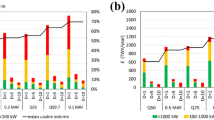Summary
The development of alternative and renewable energy sources is today most often focused on biomass and wind energy. In contrast, the usage of hydro power, especially small scale hydro power, still offers a great potential from a technological point of view. Still, for ecologic, economic and social reasons, further utilization of hydro power is limited. Here, a new technology, the water vortex power plant, is proposed for small scale applications, and its potential performance is evaluated. Experiences with already existing water vortex power plants have shown that the impact on rivers and creeks is low and that the plant has a positive effect on the river's bio activity. Even more, this plant type can be operated already with relatively low water fall height.
Zusammenfassung
Bei der derzeitigen Erschließung von alternativen und erneuerbaren Energiequellen finden in erster Linie Biomasse und Windkraft Beachtung. Im Vergleich dazu bietet die Nutzung der Wasserkraft in der Form von Kleinwasserkraftwerken nach wie vor ein sehr großes Ausbaupotential. Dieses ist jedoch aus ökologischen, ökonomischen oder gesellschaftlichen Gründen in seiner Akzeptanz begrenzt. In dieser Arbeit wird eine neue Technologie, das Wasserwirbelkraftwerk, vorgestellt und im Hinblick auf die potentielle elektrische Leistungsabgabe bewertet. Bisherige Betriebserfahrungen haben gezeigt, dass der neue Kraftwerkstyp nur einen geringen Eingriff in Bach- und Flusslandschaften darstellt und sich positiv auf deren Bioaktivität auswirkt. Des Weiteren können solche Kraftwerke schon bei sehr geringer Fallhöhe wirtschaftlich betrieben werden.
Similar content being viewed by others
Literatur
Gersten, K. (2006): Einführung in die Strömungsmechanik. Berlin: Springer, S. 60–64
Marutzky, R., Seeger, K. (2002): Energie aus Holz und anderer Biomasse. Erster unveränderter Nachdruck. Echterdingen: DRW-Verlag, S. 1
Panhauser, W., Lampl, J. (2007): EU-Wasserrahmenrichtlinie (WRRL) – Bedeutung für die Kleinwasserkraft Österreichs. Österreichische Wasser- und Abfallwirtschaft. 5, H. 6, S. 15
Pelikan, B. (2009): Technologische und konzeptive Entwicklungen in der Kleinwasserkraft. e&i (126), H. 12, S. 427–431
Penche, C. (2004): Guide on how to plan a small hydro power plant. Brussels: European small hydropower association, S. 51–59
Staiß, F. (2007): Jahrbuch erneuerbare Energien. Stiftung Energieforschung Baden-Württemberg. Radebeul: Bieberstein-Verlag, S. 207–211
Styger, D. (2010): Mit dem Wasser wirbeln. Bau LIFE, S. 20–22
Ramsauer, F. (2010): Die Herausforderungen der Wasserkraft. e&i (127), H. 1/2, S. 1
Rathke, J., Zotloeterer, F., Wendland, M. (2012) Kleinwasserkraft mit Gravitationswirbel. BWK, 64, H. 3: 54–57
Zotlöterer, F. (2011): Das Gravitationswasserwirbelkraftwerk. Zement+Beton, H. 3: 36–39
Zotlöterer, F. (2012): Persönliche Mitteilungen
Author information
Authors and Affiliations
Rights and permissions
About this article
Cite this article
Rathke, J., Wendland, M. Das Leistungspotential von Wasserwirbelkraftwerken. Elektrotech. Inftech. 129, 174–178 (2012). https://doi.org/10.1007/s00502-012-0098-9
Received:
Accepted:
Issue Date:
DOI: https://doi.org/10.1007/s00502-012-0098-9




